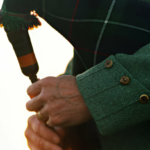Explore The Kilts: Scotland’s most Iconic Symbol of Heritage and Culture, Woven intricately into the fabric of its heart and history .Captured Scotland’s Heart and History one garment stands out as a timeless emblem of tradition and pride the kilt. But how did this distinctive piece of attire come to capture the hearts of Scots and enthusiasts around the world? Join us as we unravel the rich tapestry of history and culture woven into the fabric of the kilt.
The Historical Tapestry:
Centuries ago, Scottish Highlanders roamed the rugged terrain, clad in garments that provided both warmth and freedom of movement. The precursor to the modern kilt, known as the belted plaid or feileadh mor served as practical attire for daily life in the Highlands. Its versatile design made it ideal for hunting, farming, and even battle, reflecting the resilience and resourcefulness of the Scottish people.
Cultural Identity and Clan Allegiance:
As Scotland’s clans flourished, so too did the significance of tartan patterns and clan affiliations. The introduction of specific tartans associated with different clans fostered a sense of kinship and identity among Scots. The Kilts became more than just clothing; they became symbols of heritage, pride, and allegiance to one’s clan and community.
Royal Patronage and Global Appeal:
In the 19th century, kilts received a royal seal of approval when members of the British monarchy, including Queen Victoria and Prince Albert, embraced Scottish culture. Their endorsement catapulted kilts into the spotlight, sparking a renewed interest in Scottish traditions not only in Scotland but also across the British Empire and beyond. Kilts became fashionable attire for formal occasions, military regalia, and even everyday wear, captivating imaginations around the world.
Romanticism and Literary Influence:
The allure of kilts extended beyond practicality and prestige; it became intertwined with Scotland’s romantic landscapes and legendary tales. Scottish literature, folklore, and art romanticized the kilt as a symbol of rugged independence, bravery, and timeless charm. From the pages of Sir Walter Scott’s novels to the brushstrokes of renowned artists. Kilts became synonymous with the spirit of Scotland itself.
Conclusion:
In the annals of Scottish history, few garments hold as much significance and splendor as the kilt. Its journey from humble beginnings to global icon is a testament to the enduring power of tradition, identity, and cultural pride. Today, whether worn at weddings, or Highland gatherings. The kilt remains a cherished symbol of Scotland’s rich heritage and enduring spirit.
Join us as we celebrate the legacy of the kilt and explore the threads that bind Scotland’s past, present, and future. From the Highlands to the heart of every Scot, the kilt continues to weave its magic, embodying the timeless spirit of Caledonia. Why Kilts Captured Scotland’s Heart and History.
Last modified: February 6, 2025



